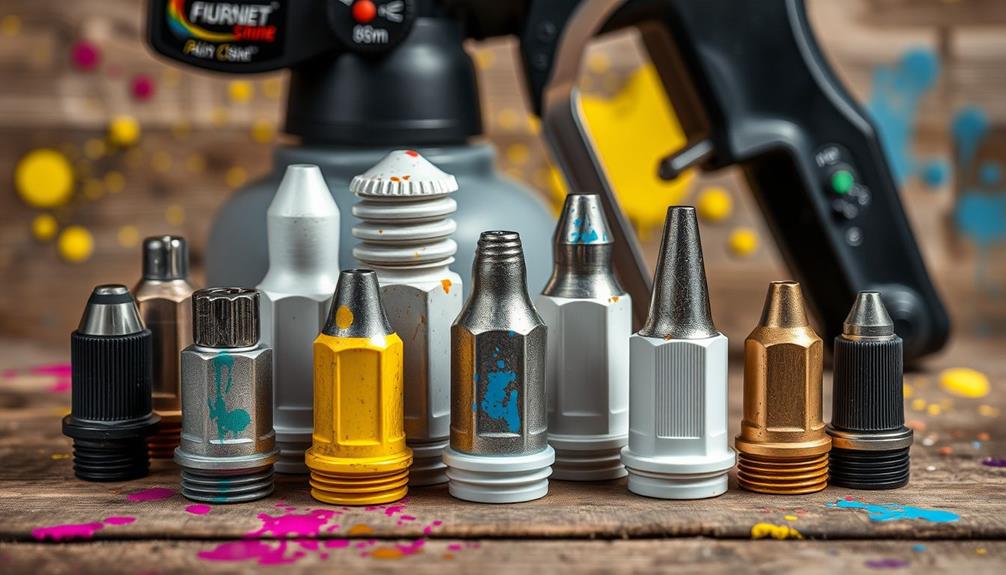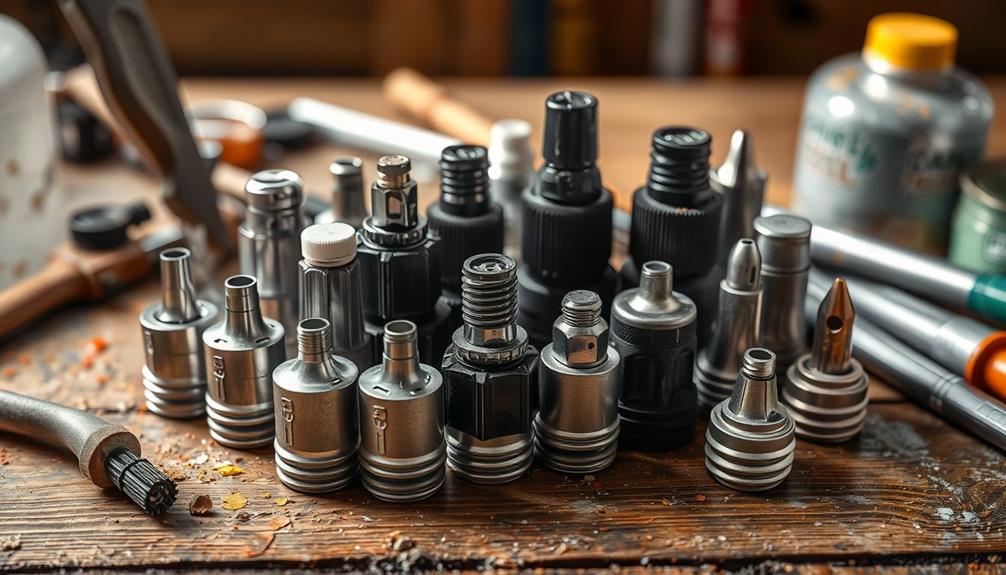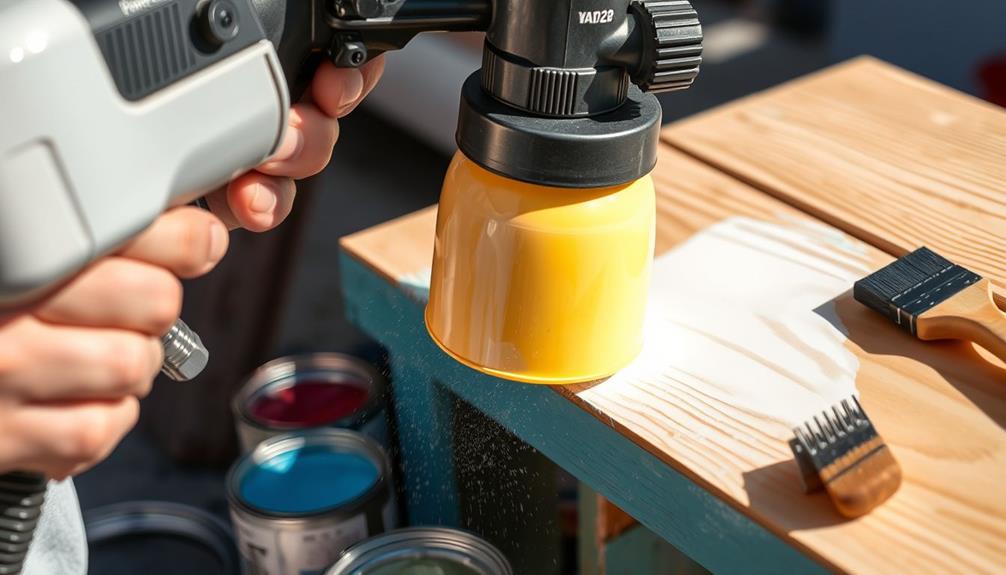Choosing the right tip size for your airless paint sprayer is essential for a smooth finish and to reduce overspray. Start by checking the manufacturer's recommendations, which match tip sizes to specific materials. Pay attention to the three-digit code on the tip, where the first number indicates the spray fan width and the last two numbers represent the orifice size. For larger surfaces, opt for wider fan widths, while narrower tips work best for detail work. Selecting the correct size based on the paint's viscosity is equally important. There's a lot more to explore to guarantee superior spraying results.
Key Takeaways
- Select tip size based on coating viscosity; larger orifices suit thick materials, while smaller ones are ideal for thinner coatings like stains.
- Check the manufacturer's recommendations for appropriate tip sizes according to the specific material being used for optimal results.
- Consider fan width for coverage; larger widths are better for broad surfaces, while smaller widths are suited for detailed work.
- Regularly clean and maintain tips to prevent wear and extend their lifespan, ensuring consistent spray patterns and quality application.
- Verify sprayer compatibility with tip sizes, ensuring the maximum orifice size and fan width align with the sprayer's specifications.
Importance of Tip Size
When it comes to achieving a flawless finish with your airless paint sprayer, the significance of tip size can't be overstated. The correct tip size directly affects fluid output and the width of your spray fan, making it necessary for a professional finish.
Tip sizes are indicated by a three-digit code: the first digit, doubled, represents the fan width in inches, while the last two digits indicate the orifice size in thousandths of an inch. Choosing the right tip size is particularly essential for projects that require intricate detailing, as using a Graco FFLP Fine Finish Low Pressure Reversible Tip can greatly enhance your control and reduce overspray.
Selecting the appropriate tip size based on the coating viscosity is imperative for ideal paint atomization and flow. If you're working with thinner materials, a smaller orifice is recommended, while thicker coatings require a larger size.
Keep an eye on worn tips, as they can markedly alter your spray pattern, leading to increased paint usage and poor application. Timely tip replacement is necessary for maintaining quality.
Manufacturers often provide recommended tip sizes on their packaging, simplifying the selection process and helping you match the tip to the specific material application.
Understanding Tip Specifications

When choosing a spray tip, you'll notice a three-digit code that reveals essential information. The first number doubled shows the spray fan width, while the last two digits indicate the orifice size in thousandths of an inch.
Selecting the right tip is vital for achieving an even finish and optimizing your application speed, especially when working on larger surfaces like walls and fences.
Understanding these specifications helps you optimize flow rate and achieve the perfect finish for your project, making it easier to learn about best practices for airless sprayers.
Tip Size Explained
Understanding tip sizes is fundamental for achieving the best results with your airless paint sprayer. The tip size is indicated by a three-digit code, where the first digit multiplied by two gives you the fan's width in inches, and the last two digits represent the orifice size in thousandths of an inch.
For instance, a 515 tip has a 10-inch fan and a 15-thousandths orifice. Selecting the right tip size can greatly enhance your painting experience, much like choosing the perfect island getaways for relaxation and adventure.
The orifice size directly impacts the flow rate of your coating material. Larger orifices allow more material to exit, which is essential for achieving the desired coating thickness.
When dealing with different viscosities, it's critical to select the correct orifice size; thin coatings like stains require smaller sizes (009-011), while thicker materials like latex paint need larger sizes (015-025).
Tip wear can greatly affect your spray performance. Worn tips increase the orifice size and decrease the fan width, leading to inefficient patterns and wasted paint.
Regular maintenance and timely tip replacement are key to ensuring ideal performance and a quality finish, as tungsten carbide tips typically last for 300-600 liters of paint.
Orifice Impact on Flow
Tip specifications play a significant role in your airless spray painting efficiency, particularly the orifice size. The orifice, indicated by the last two digits of your spray tip's code, directly affects fluid flow and coverage. For example, a 515 tip has an orifice size of 15 thousandths of an inch.
Choosing a larger orifice allows for greater fluid flow, making it ideal for thicker materials like latex paints and primers. Conversely, smaller orifices are better for thinner coatings such as stains and lacquers. Proper selection of equipment, much like home theater setup essentials, is vital for peak performance.
The flow rate is critical; a .017 tip sprays at .31 GPM, while a .019 tip can handle .40 GPM, allowing you to cover more area faster. An increase in orifice size means delivering more paint per square inch, impacting the mil thickness of your applied coating.
Selecting the correct orifice size is important for achieving an even coating. If you use an inappropriate size, you risk issues like overspray or inadequate coverage. As a result, always match your spray tip to the material being applied to guarantee peak results.
Selecting the Right Tip

When selecting the right tip for your airless paint sprayer, you'll want to take into account both the fan width and orifice size.
The fan width affects your coverage area, while the orifice size determines how much paint flows through the tip. Matching these factors to your material will guarantee a smooth and efficient application.
Additionally, understanding the impact of proper maintenance on equipment performance can enhance your spraying experience, just as regular inspection of seals and connections can prevent leaks in plumbing systems.
Fan Width Considerations
Selecting the right fan width for your airless paint sprayer is essential for achieving the best results. The fan width greatly affects your paint flow and coverage per square inch, so understanding how to choose the right one will enhance your efficiency and help you achieve a professional finish.
Additionally, guaranteeing proper safety measures while spraying can protect your eyes, making the use of safety glasses critical in this process.
Here are some key considerations for selecting the right fan width:
- Match the Surface Size: Use larger widths for broad surfaces like walls and ceilings, while smaller widths are better for detailed work, such as cabinets and furniture.
- Tip Size Interpretation: The first number in a spray tip size indicates the fan width at 12 inches from the surface. For instance, a 517 tip produces a 10-inch fan width.
- Adjust for Material: The fan width can vary by up to 2 inches based on your sprayer pressure and the coating manufacturers' specifications.
- Coating Thickness: Wider fan widths result in thinner coatings, which can affect the overall coverage. Make sure you choose a width that balances coverage with the desired paint thickness.
Orifice Size Selection
Choosing the right orifice size is essential for achieving the best results with your airless paint sprayer. The orifice size, indicated by the last two digits of the spray tip number, directly impacts paint atomization, flow, and finish quality. For peak performance, you need to match the orifice size to your materials.
Here's a quick reference table to help you select the appropriate orifice size:
| Orifice Size | Suitable Materials |
|---|---|
| .009 – .013 | Stains, Sealers |
| .015 | Standard Latex Paints |
| .021 | Heavy Latex, Elastomerics |
| .025 – .035 | Primers, Textured Coatings |
Material Compatibility Factors
To achieve the best results with your airless paint sprayer, understanding material compatibility is crucial. The orifice size of your spray tip must align with the material viscosity. Here are some key points to reflect upon:
- Thinner materials: For products like stains or clear coats, choose an orifice size between .009 to .013 inches to guarantee proper atomization.
- Thicker materials: Latex paints typically require larger orifice sizes, ranging from .015 to .025 inches, for peak coverage.
- Manufacturer's recommendations: Always check the packaging for guidance on the appropriate tip size to avoid issues with atomization and coverage.
- Fan width: Match the spray tip's fan width to your project's surface area; larger fans are ideal for broad surfaces like walls, while smaller fans suit detailed work on furniture or cabinets.
Recommended Tip Sizes

When it comes to achieving the best results with your airless paint sprayer, knowing the right tip size for your material is essential. Choosing the correct orifice size will greatly impact your application's effectiveness. Here's a quick reference for recommended tip sizes based on the type of paint you're using:
| Material Type | Recommended Tip Size (Orifice Size) |
|---|---|
| Light Coatings | .009 to .013 |
| Oil-Based Paints | .013 to .015 |
| Latex Paints | .015 to .019 |
| Heavy Coatings | .025 to .035 |
For light coatings, like stains and lacquers, smaller tip sizes allow for fine control. Oil-based paints usually require a slightly larger size to guarantee proper flow, while latex paints benefit from medium tip sizes due to their viscosity. Heavier coatings, such as elastomerics, need the largest orifice sizes for effective application. Always refer to the manufacturer's specifications and technical data sheets for the most accurate recommendations based on the specific material you're using. This will help you achieve the best results with your paint sprayer.
Tip Wear and Maintenance

Maintaining your airless spray tips is essential for achieving consistent, high-quality finishes. Proper maintenance not only enhances performance but also prolongs the tip lifespan.
Remember, airless spray tips typically wear out after 300-600 liters of paint. You should replace them when you notice a 25% loss in fan width; otherwise, you'll face increased paint usage and decreased finish quality.
Having a robust home security system can provide peace of mind while you focus on your painting projects.
Here are four key maintenance tips:
- Clean Regularly: Use soft bristle brushes to clean your spray tips after each use. Avoid metal brushes, as they can damage the tips and lead to corrosion.
- Check Filters: Clean the gun and manifold filters after every use to maintain peak performance and reduce wear on your tips.
- Store Properly: Store your tips in protective solutions like Pump Armor. This helps prevent corrosion and extends their usable life.
- Monitor Usage: Keep track of the amount of paint applied. If you notice changes in spray patterns, it may be time to replace your tips.
Extending Tip Life

Extending the life of your airless spray tips is essential for maintaining efficiency and quality in your painting projects. By following a few simple practices, you can minimize tip wear and prolong their lifespan. Here's a quick guide to help you:
| Practice | Description |
|---|---|
| Use Minimum Pressure | Apply the least pressure necessary for effective atomization to reduce wear. |
| Regularly Clean Spray Tips | Use soft bristle brushes to clean tips, avoiding metal brushes that can scratch. |
| Strain Materials | Straining paint before spraying minimizes grit, contributing to smoother operation. |
| Replace Tips | Change tips after a 25% loss in fan width to maintain peak performance and reduce paint wastage. |
| Store in Protective Solutions | Use products like Pump Armor to prevent corrosion and extend tip life when not in use. |
Advanced Tip Options

Exploring advanced tip options for your airless paint sprayer can greatly enhance your painting experience and results.
With the right airless spray tips, you can achieve peak performance and finish quality. Additionally, consider how energy-efficient models can minimize operational costs in your painting projects.
Here are some advanced tips you might consider:
- Reverse-A-Clean (RAC) Tips: These tips allow you to easily clear clogs by reversing the tip, minimizing downtime on your projects.
- RAC-X Fine Finish Tips: Designed for low-pressure spraying, these tips produce high-quality finishes on cabinetry and fine materials while reducing overspray.
- WideRAC SwitchTips: Perfect for large surface areas, these tips create expansive fan patterns up to 24 inches wide, making them ideal for high production environments.
- XHD RAC SwitchTips: Tailored for heavy coatings, these pressure tips can operate at higher pressures, ensuring efficient application of thick materials.
Checking Sprayer Compatibility

Ensuring compatibility between your airless paint sprayer and the selected spray tip is essential for achieving ideal results. Start by consulting your sprayer's manual to identify the compatible tip sizes based on your model's specifications.
Each airless paint sprayer comes with a maximum orifice size that you shouldn't exceed. This limit varies considerably depending on the GPM rating of your sprayer. Using a tip that exceeds this rating can lead to performance issues or even damage.
It's also important to take into account the range of services offered when selecting equipment, as this can influence your overall project efficiency.
Next, examine the fan width of the spray tip. It should match the size of the application surface for the best coverage and efficiency.
If you choose a tip that's too wide or narrow, you'll likely experience inefficient spraying patterns, leading to wasted paint and higher labor costs.
Frequently Asked Questions
What Size Tip Do You Use on an Airless Sprayer?
You'll use a tip size based on the coating's viscosity. For thin materials, select smaller orifices, while thicker paints require larger sizes. Matching your sprayer's GPM rating guarantees peak performance and a great finish.
How Do I Know My Spray Tip Size?
Think of your spray tip size as a key revealing your project's potential. To know your size, check the three-digit code on the tip. The first digit shows the fan width; the last two indicate orifice size.
How Do I Know What Size Nozzle to Get for My Spray Gun?
To determine your spray gun's nozzle size, consider the materials you'll use and your desired finish. Check your sprayer's manual for compatibility, and remember that application distance and maintenance also play essential roles in your choice.
What Is the Difference Between 517 and 515 Spray Tip?
The 517 tip has a wider orifice and creates a thicker spray compared to the 515. If you're using latex or medium viscosity materials, the 517's flow rate might suit your project better.
Conclusion
Choosing the right tip size for your airless paint sprayer is essential for achieving that flawless finish you desire. By understanding specifications and selecting suitable sizes, you'll save time and frustration. Remember, proper maintenance and mindful management of your tips will maximize their lifespan. So, immerse yourself in the world of dazzling designs, and with the right tools, transform your projects into stunning showcases. Your sprayer's success starts with smart choices—so spray smart and shine bright!










